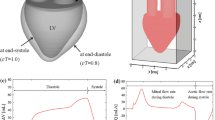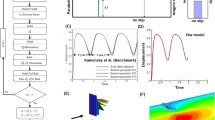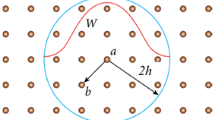Abstract
We have performed high-resolution fluid–structure interaction simulations of physiologic pulsatile flow through a bi-leaflet mechanical heart valve (BMHV) in an anatomically realistic aorta. The results are compared with numerical simulations of the flow through an identical BMHV implanted in a straight aorta. The comparisons show that although some of the salient features of the flow remain the same, the aorta geometry can have a major effect on both the flow patterns and the motion of the valve leaflets. For the studied configuration, for instance, the BMHV leaflets in the anatomic aorta open much faster and undergo a greater rebound during closing than the same valve in the straight axisymmetric aorta. Even though the characteristic triple-jet structure does emerge downstream of the leaflets for both cases, for the anatomic case the leaflet jets spread laterally and diffuse much faster than in the straight aorta due to the aortic curvature and complex shape of the anatomic sinus. Consequently the leaflet shear layers in the anatomic case remain laminar and organized for a larger portion of the accelerating phase as compared to the shear layers in the straight aorta, which begin to undergo laminar instabilities well before peak systole is reached. For both cases, however, the flow undergoes a very similar explosive transition to the small-scale, turbulent-like state just prior to reaching peak systole. The local maximum shear stress is used as a metric to characterize the mechanical environment experienced by blood cells. Pockets of high local maximum shear are found to be significantly more widespread in the anatomic aorta than in the straight aorta throughout the cardiac cycle. Pockets of high local maximum shear were located near the leaflets and in the aortic arc region. This work clearly demonstrates the importance of the aortic geometry on the flow phenomena in a BMHV and demonstrates the potential of our computational method to carry out image-based patient-specific simulations for clinically relevant studies of heart valve hemodynamics.















Similar content being viewed by others
References
Borazjani, I. Numerical simulations of fluid/structure interaction problems in biological flows. PhD thesis, University of Minnesota, June 2008.
Borazjani, I., L. Ge, and F. Sotiropoulos. Curvilinear immersed boundary method for simulating fluid structure interaction with complex 3d rigid bodies. J. Comput. Phys. 227(16):7587–7620, 2008.
Borazjani, I., and F. Sotiropoulos. Numerical investigation of the hydrodynamics of carangiform swimming in the transitional and inertial flow regimes. J. Exp. Biol. 211:1541–1558, 2008.
Chandran, K. B., G. N. Cabell, B. Khalighi, and C. J. Chen. Laser anemometry measurements of pulsatile flow past aortic valve prostheses. J. Biomech. 16(10):865–873, 1983.
Cheng, R., Y. G. Lai, and K. B. Chandran. Two-dimensional fluid–structure interaction simulation of bileaflet mechanical heart valve flow dynamics. J. Heart Valve Dis. 12(6):772–780, 2003.
Cheng, R., Y. G. Lai, and K. B. Chandran. Three-dimensional fluid–structure interaction simulation of bileaflet mechanical heart valve flow dynamics. Ann. Biomed. Eng. 32(11):1471–1483, 2004.
Dasi, L. P., L. Ge, H. A. Simon, F. Sotiropoulos, and A. P. Yoganathan. Vorticity dynamics of a bileaflet mechanical heart valve in an axisymmetric aorta. Phys. Fluids 19:067105, 2007.
de Zélicourt, D., K. Pekkan, H. Kitajima, D. Frakes, and A. P. Yoganathan. Single-step stereolithography of complex anatomical models for optical flow measurements. J. Biomech. Eng. 127:204, 2005.
Ellis, J. T., T. M. Healy, A. A. Fontaine, R. Saxena, and A. P. Yoganathan. Velocity measurements and flow patterns within the hinge region of a medtronic parallel bileaflet mechanical valve with clear housing. J. Heart Valve Dis. 5(6):591–599, 1996.
Feng, Z., M. Umezu, T. Fujimoto, T. Tsukahara, M. Nurishi, and D. Kawaguchi. In vitro hydrodynamic characteristics among three bileaflet valves in the mitral position. Artif. Organs 24(5):346–354, 2000.
Ge, L., L. P. Dasi, F. Sotiropoulos, and A. P. Yoganathan. Characterization of hemodynamic forces induced by mechanical heart valves: Reynolds vs. viscous stresses. Ann. Biomed. Eng. 36(2):276–297, 2008.
Ge, L., H. L. Leo, F. Sotiropoulos, and A. P. Yoganathan. Flow in a mechanical bileaflet heart valve at laminar and near-peak systole flow rates: Cfd simulations and experiments. J. Biomech. Eng. 127:782, 2005.
Ge, L., and F. Sotiropoulos. A numerical method for solving the 3d unsteady incompressible navierstokes equations in curvilinear domains with complex immersed boundaries. J. Comput. Phys. 225(2):1782–1809, 2007.
Gilmanov, A., and F. Sotiropoulos. A hybrid cartesian/immersed boundary method for simulating flows with 3d, geometrically complex, moving bodies. J. Comput. Phys. 207(2):457, 2005.
Grigioni, M., C. Daniele, G. D’Avenio, and V. Barbaro. The influence of the leaflets curvature on the flow field in two bileaflet prosthetic heart valves. J. Biomech. 34(5):613–621, 2001.
Grigioni, M., C. Daniele, G. D’Avenio, and V. Barbaro. Evaluation of the surface-averaged load exerted on a blood element by the Reynolds shear stress field provided by artificial cardiovascular devices. J. Biomech. 35(12):1613–1622, 2002.
Grigioni, M., C. Daniele, C. Del Gaudio, U. Morbiducci, A. Balducci, G. D’Avenio, and V. Barbaro. Three-dimensional numeric simulation of flow through an aortic bileaflet valve in a realistic model of aortic root. ASAIO J. 51(3):176, 2005.
Grinberg, L., and G. E. Karniadakis. Outflow boundary conditions for arterial networks with multiple outlets. Ann. Biomed. Eng. 36(9):1496–1514, 2008.
Heart Disease and Stroke Statistics, 2007 Update. Technical report. American Heart Association, 2007.
Huang, Z. J., C. L. Merkle, S. Abdallah, and J. M. Tarbell. Numerical simulation of unsteady laminar flow through a tilting disk heart valve: prediction of vortex shedding. J. Biomech. 27(4):391–402, 1994.
Hunt, J. C. R., A. A. Wray, and P. Moin. Eddies, streams, and convergence zones in turbulent flows. In: Studying Turbulence Using Numerical Simulation Databases, 2. Proceedings of the 1988 Summer Program (SEE N89-2453818-34), pp. 193–208, 1988.
Irons, B. M., and R. C. Tuck. A version of the aitken accelerator for computer iteration. Int. J. Numer. Methods Eng. 1(3):275–277, 1969.
King, M. J., J. Corden, T. David, and J. Fisher. A three-dimensional, time-dependent analysis of flow through a bileaflet mechanical heart valve: comparison of experimental and numerical results. J. Biomech. 29(5):609–618, 1996.
Kleine, P., M. Perthel, H. Nygaard, S. B. Hansen, P. K. Paulsen, C. Riis, and J. Laas. Medtronic hall versus st. jude medical mechanical aortic valve: downstream turbulences with respect to rotation in pigs. J. Heart Valve Dis. 7(5):548–555, 1998.
CSF Lee and L. Talbot. A fluid-mechanical study of the closure of heart valves. J. Fluid Mech. 91(1):41–63, 1979.
Liu, J. S., P. C. Lu, and S. H. Chu. Turbulence characteristics downstream of bileaflet aortic valve prostheses. J. Biomech. Eng. 122(2):118–124, 2000.
Manning, K. B., V. Kini, A. A. Fontaine, S. Deutsch, and J. M. Tarbell. Regurgitant flow field characteristics of the st. jude bileaflet mechanical heart valve under physiologic pulsatile flow using particle image velocimetry. Artif. Organs 27(9):840–846, 2003.
Marshall, I., S. Zhao, P. Papathanasopoulou, P. Hoskins, and X. Y. Xu. MRI and CFD studies of pulsatile flow in healthy and stenosed carotid bifurcation models. J. Biomech. 37(5):679–687, 2004.
Mok, D. P., W. A. Wall, and E. Ramm. Accelerated iterative substructuring schemes for instationary fluid–structure interaction. In: First MIT Conference on Computational Fluid and Solid Mechanics, pp. 1325–1328, 2001.
Nyboe, C., J. A. Funder, M. H. Smerup, H. Nygaard, and J. M. Hasenkam. Turbulent stress measurements downstream of three bileaflet heart valve designs in pigs. Eur. J. Cardiothorac Surg. 29(6):1008–1013, 2006.
Nygaard, H., P. K. Paulsen, J. M. Hasenkam, E. M. Pedersen, and P. E. Rovsing. Turbulent stresses downstream of three mechanical aortic valve prostheses in human beings. J. Thorac. Cardiovasc. Surg. 107(2):438–446, 1994.
Pekkan, K., D. Zlicourt, L. Ge, F. Sotiropoulos, D. Frakes, M. A. Fogel, and A. P. Yoganathan. Physics-driven cfd modeling of complex anatomical cardiovascular flowsa tcpc case study. Ann. Biomed. Eng. 33(3):284–300, 2005.
Peskin, C. S. The fluid dynamics of heart valves: experimental, theoretical, and computational methods. Annu. Rev. Fluid Mech. 14(1):235–259, 1982.
Scotten, L. N., and D. K. Walker. New laboratory technique measures projected dynamic area of prosthetic heart valves. J. Heart Valve Dis., 13(1):120–32, 2004.
Sotiropoulos, F., and I. Borazjani. A review of state-of-the-art numerical methods for simulating flow through mechanical heart valves. Med. Biol. Eng. Comput. 47:245–256, 2009.
Steinman, D. A., J. S. Milner, C. J. Norley, S. P. Lownie, and D. W. Holdsworth. Image-based computational simulation of flow dynamics in a giant intracranial aneurysm. Am. J. Neuroradiol. 24(4):559–566, 2003.
Travis, B. R., H. L. Leo, P. A. Shah, D. H. Frakes, and A. P. Yoganathan. An analysis of turbulent shear stresses in leakage flow through a bileaflet mechanical prostheses. J. Biomech. Eng. 124(2):155–165, 2002.
Vorp, D. A., D. A. Steinman, and C. R. Ethier. Computational modeling of arterial biomechanics. Comput. Sci. Eng. 3(5):51–64, 2001.
Yoganathan, A. P., Z. He, and S. C. Jones. Fluid mechanics of heart valves. Annu. Rev. Biomed. Eng. 6:331–362, 2004.
Yoganathan, A. P., Y. R. Woo, and H. W. Sung. Turbulent shear stress measurements in the vicinity of aortic heart valve prostheses. J. Biomech. 19(6):433–442, 1986.
Acknowledgments
This work was supported by NIH Grant RO1-HL-07262 and the Minnesota Supercomputing Institute. We thank Ajit Yoganathan and the members of the Cardiovascular Fluid Mechanics Laboratory for providing us with the anatomic aorta geometry used in this study.
Author information
Authors and Affiliations
Corresponding author
Rights and permissions
About this article
Cite this article
Borazjani, I., Ge, L. & Sotiropoulos, F. High-Resolution Fluid–Structure Interaction Simulations of Flow Through a Bi-Leaflet Mechanical Heart Valve in an Anatomic Aorta. Ann Biomed Eng 38, 326–344 (2010). https://doi.org/10.1007/s10439-009-9807-x
Received:
Accepted:
Published:
Issue Date:
DOI: https://doi.org/10.1007/s10439-009-9807-x




